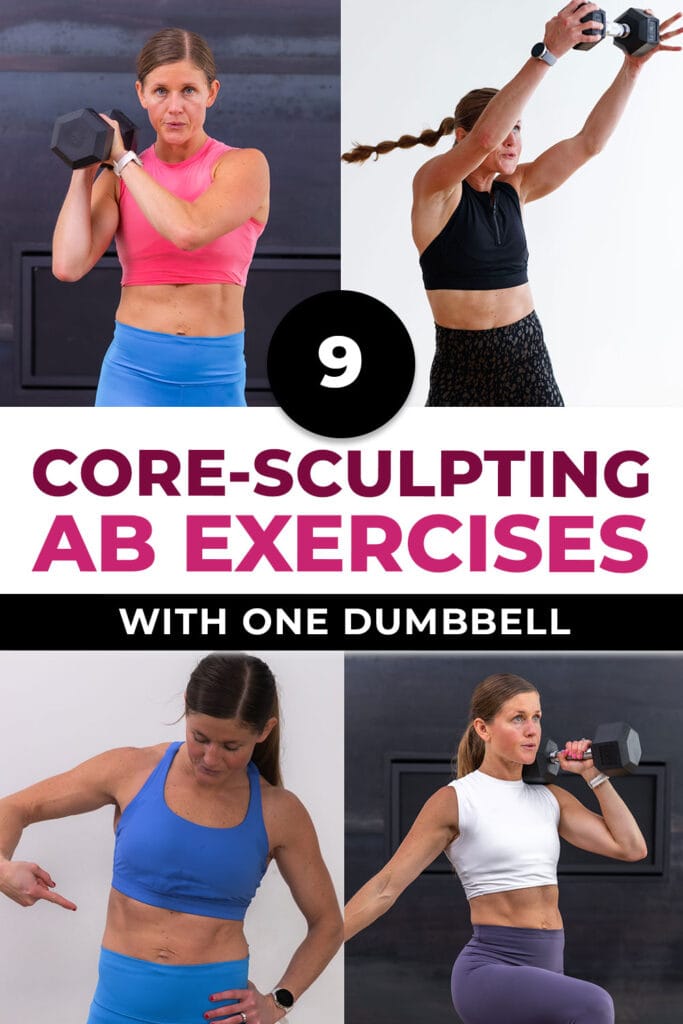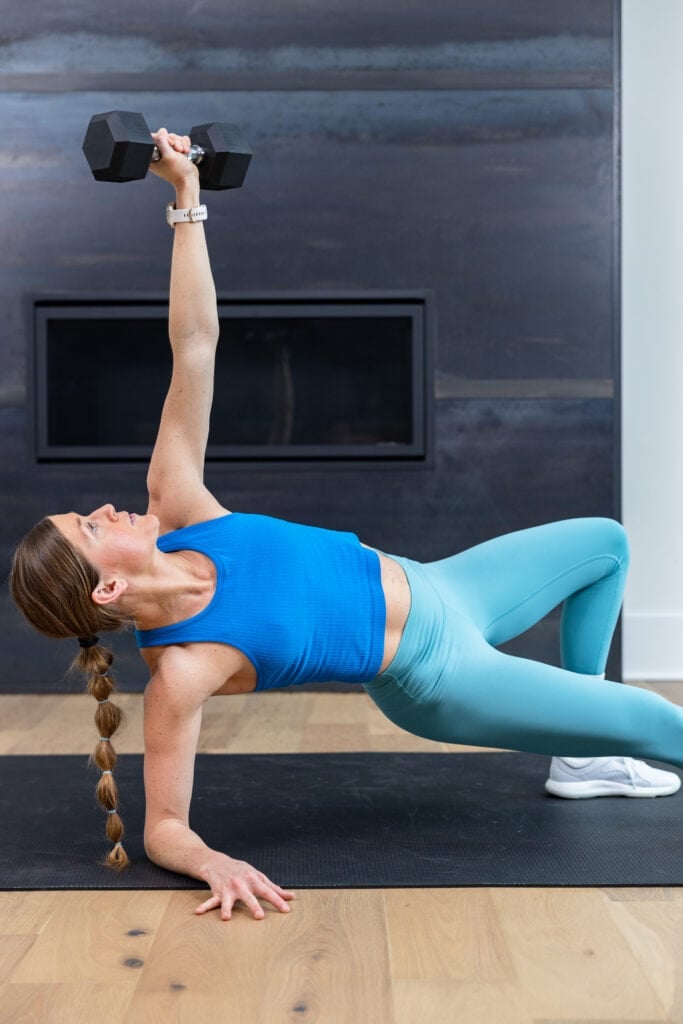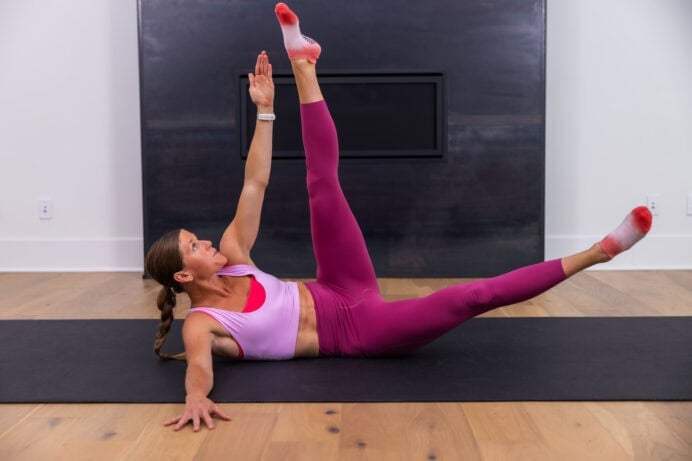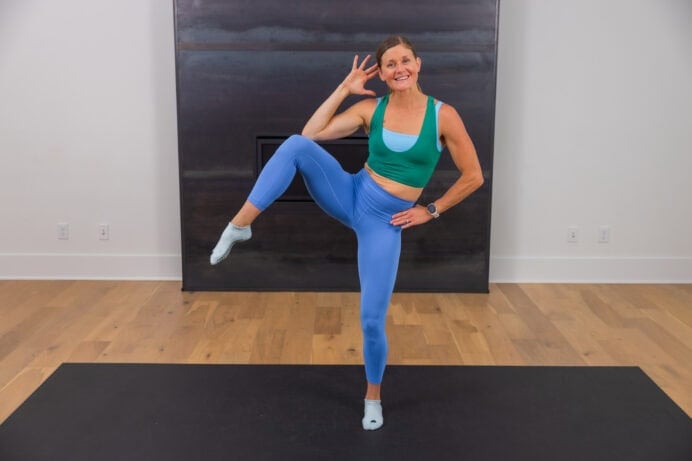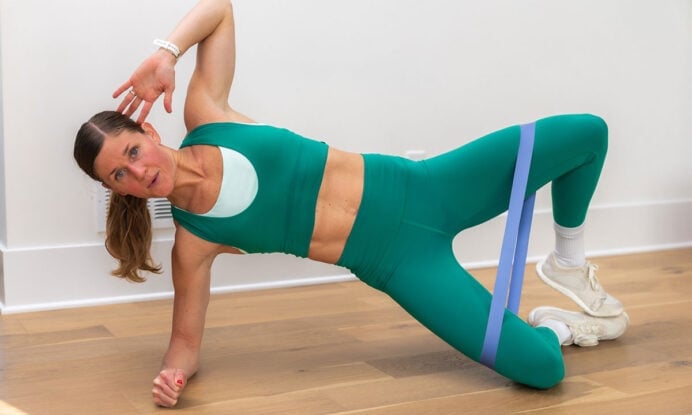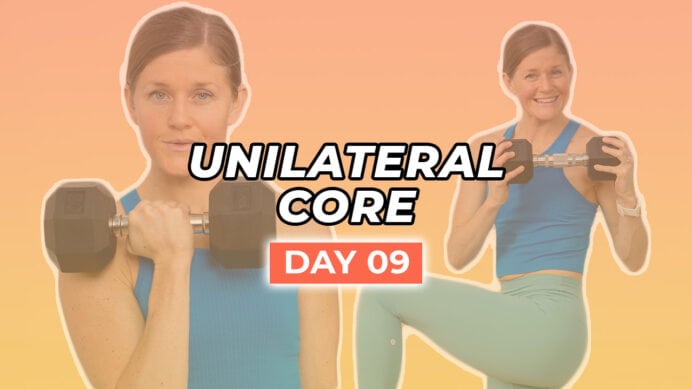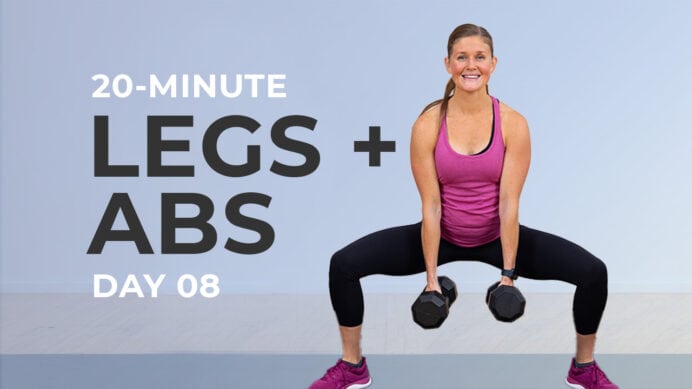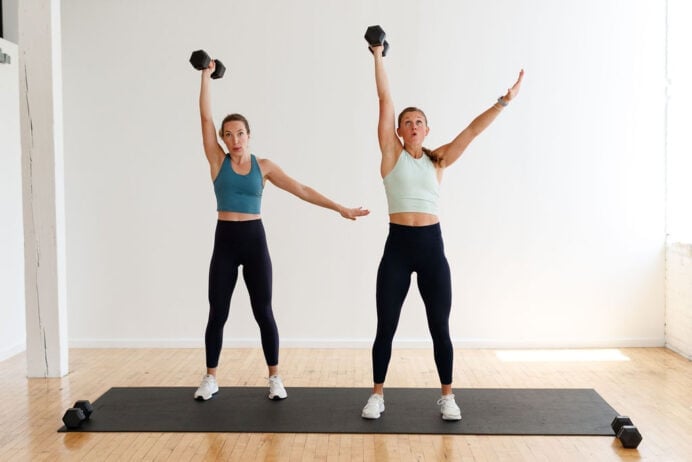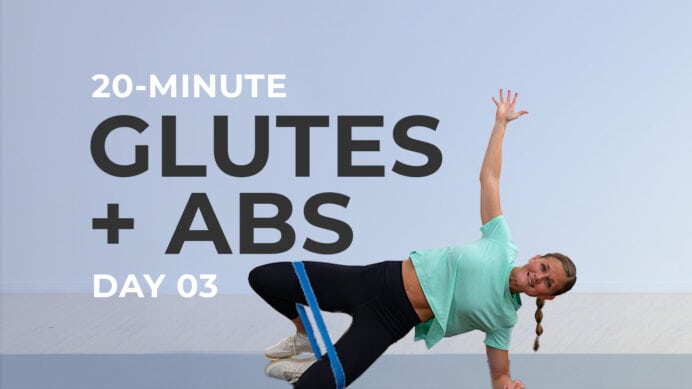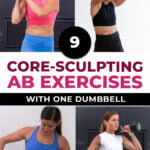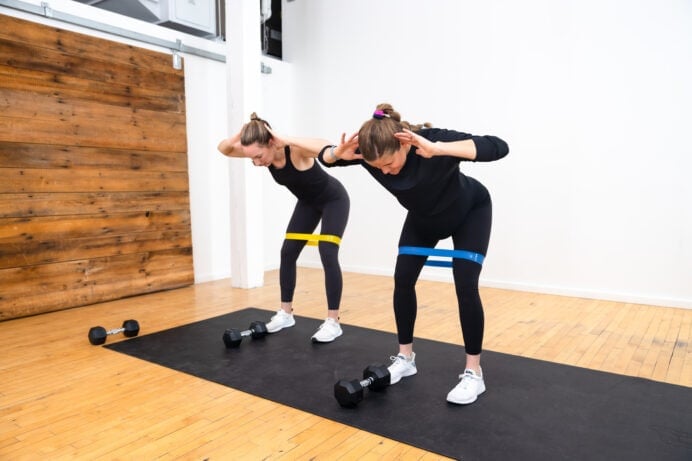
9 Dumbbell Exercises for Abs
Build a functional, defined core with this dumbbell ab workout! 9 of the best weighted ab exercises designed to target the lower abs, upper abs, obliques and deep core/pelvic floor at home. Increase core strength, reduce lower back pain and improve balance and stability with these dumbbell ab exercises.
In my 20s, I thought the most effective way to build six-pack abs was through endless crunches and sit-ups. In my 30s (after rebuilding my core 3 times during and after pregnancy!) I’ve learned the truth: the abs, just like any other muscle group, benefit from strength training.
While bodyweight exercises like crunches may make you “feel the burn,” dumbbell ab workouts lead to:
- Muscle Growth (Hypertrophy): To build visible abs, you need to develop the rectus abdominis and surrounding core muscles. These muscles (just like those found in your upper and lower body) are built through progressive overload, or increasing the difficulty over time by increasing reps performed or weights used.
- Reduced Body Fat: Ab muscles become visible when body fat percentage decreases. Strength training is the best way to increase your overall metabolism, burning more calories and fat while your body is at rest.
- Functional Core Strength: Compound lifts (like squats, deadlifts and overhead presses) and weighted ab exercises train the core dynamically, under load. This builds real-world core strength, stability and definition.
Today’s core workout includes 9 of my favorite ab toning exercises to target the upper abs, lower abs, obliques and deep core and pelvic floor from all angles. A combination of rotation and anti-rotation ab exercises build strength and stability throughout the core. This functional style of training prepares you for your real-life movements, like pivots, twists and running.
Workout Equipment:
A medium-to-heavy set of dumbbells. I suggest anywhere from 5-25 lbs. If you’re a beginner, try performing these exercises with just your bodyweight or a light dumbbell. If you’re more advanced, use a heavy dumbbell, resistance band or kettlebell.
Workout Instructions:
Note that this is a list of my favorite dumbbell exercises for abs. If you prefer a full guided workout video (complete with a warm-up and cool-down), try this Dumbbell Ab Home Workout.
How To Use This Dumbbell Ab Workout:
- Beginner: 30 seconds work, 15 seconds rest. Perform each exercise x1 set.
- Intermediate: 40 seconds work, 20 seconds rest. Perform each exercise x2 sets.
- Advanced: 45 seconds work, 15 seconds rest. Perform each exercise x3 sets.
Workout Outline
1. Dumbbell Crunches
Targets: The upper abs and lower abs.
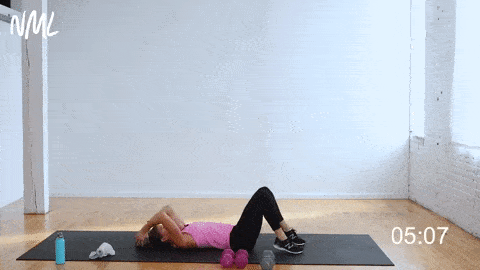
How To Do a Dumbbell Crunch
- Start lying flat on your back, lower back pressing firmly into the mat. Bring your legs to a 90-degree bend, feet pressing firmly into the ground.
- Hold a dumbbell horizontally between your hands, elbows bent at 90 degrees and dumbbell touching the floor.
- Perform a crunch by lifting your head, neck and shoulders off the ground as you pull the dumbbell in towards your knees. Simultaneously lift the feet off the floor, pulling the knees in to meet the elbows if you can.
- With control, lower the feet back toward the ground as you also lower the dumbbell back to the ground.
2. Side Planks
Targets: Internal and external oblique muscles and transverse abdominis.
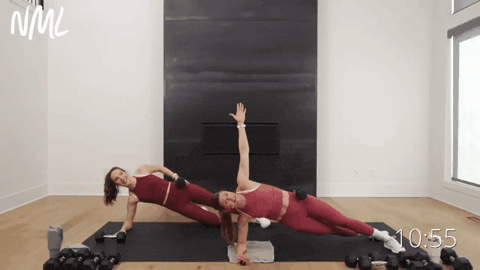
How To Do A Side Plank
- Start lying on your right side, right forearm on the mat, right shoulder stacked over right elbow. Option to place a dumbbell on your left hip to increase the difficulty.
- Press into your forearm and lift your hips. Balance on the outside edge of your right foot, stacking your left foot on top of your right foot. Option to drop your right knee to the mat for more support.
- Extend your left hand overhead. Focus on keeping your hips high and even (stacked over each other).
3. Russian Twists
Targets: Upper abs, lower abs, obliques, core and hips.
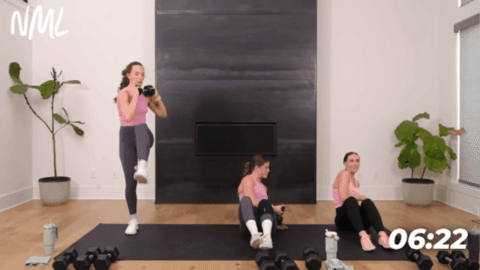
How To Do A Dumbbell Seated Twist (Russian Twist)
- Start in a seated position on the ground or on a yoga mat. Lean your torso back until you feel your core engage. Option to hold a dumbbell horizontally in both hands. To make it more difficult, float one or both feet off the ground.
- On an exhale, rotate your shoulders and torso to the right as you bring the dumbbell to tap the mat outside of your right hip. Inhale as you use your obliques and outer abs to return your chest to center.
- Then repeat on the opposite side, rotating your shoulders to the left as you bring the dumbbell to tap the mat outside of your left hip.
4. Side Bends
Targets: Obliques, upper abs, and lower back.

How To Do A Standing Oblique Crunch (Side Bend)
- Stand with feet hip-width apart, knees slightly bent. Place a resistance band six inches above your ankle joints (around your calves/shins). Hold a dumbbell in your left hand at your side.
- Allow the weight in your left hand to pull you down, sliding the weight down your left thigh and bending through your left side. You should feel a stretch in the opposite (right) obliques.
- Squeeze through your right outer ab muscles to pull your torso upright, returning to the starting position.
5. Sit-Ups
Targets: All of the ab muscles, including the lower abs, upper abs, obliques, hips, shoulders and chest.
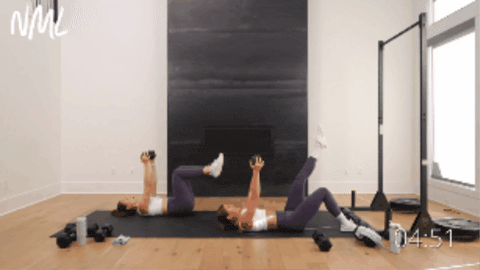
How To Do A Single-Leg Toe-Touch Weighted Sit-Up
- Start lying flat on your back, knees bent and feet planted on the floor. Straighten your left knee so your left toes are floating off the floor. Hold one dumbbell between both hands straight above your chest, wrists stacked over your shoulders.
- Pull your belly button towards your spine to engage your abdominal muscles.
- Exhale as you lift your upper body off the ground, sitting up to bring your torso towards your knees. At the same time, pull your left toes towards your midline, aiming to tap your left toes with the dumbbell.
- Inhale as you lower down, returning to the starting position.
6. Dumbbell Push-Ups and Plank Rows
Targets: Latissimus dorsi (or lats), upper back, chest, shoulders, triceps, arms and core.
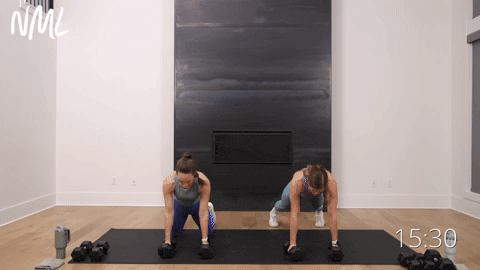
How To Do A Push Up and Plank Row (Renegade Rows)
- Start in a high plank position, both hands on your dumbbells, shoulders stacked over wrists, core engaged.
- Slowly lower your chest down towards the ground as your elbows fall back towards your hips (keep elbows tight to the body).
- Once at the bottom of your push-up, exhale as you push back up into a high plank position (top of your push-up position).
- Then, hold a high plank position as you pull your right elbow towards your right hip, squeezing your back muscles to lift the dumbbell in your right hand, performing a plank and row.
- Slowly and with control, lower the dumbbell to the ground.
- Continue this pattern, alternating one push-up with one renegade row, switching the arm that performs the back row after each push-up.
Modification: If you can’t do a full push-up on your toes, you can substitute one of these push-up modifications. I also highly recommend working through my free 12-week push-up progression program. If push-ups hurt your wrist, substitute one of these exercises for wrist pain.
7. Dumbbell Chops (Wood Chops)
Targets: Internal obliques, external obliques, deep transversus abdominis muscles, hips, back and shoulders.
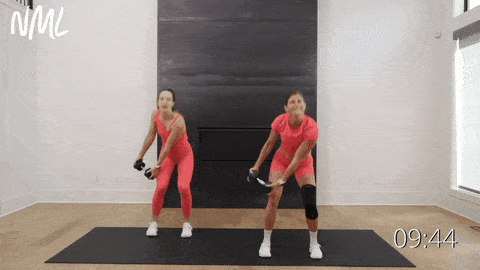
How To Do Wood Chops
- Start standing in an athletic stance, feet shoulder-width apart, soft bend in your knees, core engaged. Stagger your feet, so your left foot is slightly behind your right. Most of your weight is in your right foot.
- Hold one dumbbell horizontally between your hands.
- Bend your knees as you bring the dumbbell to the outside of your left knee.
- Then exhale as you use your legs, hips, glutes, abs and obliques to drive the dumbbell crossbody, extending your arms up overhead on the right side. Think about driving the weight from your left knee to your right shoulder.
- Lower the dumbbell with control back towards your left knee, returning to the starting position.
8. Dumbbell Dead Bugs
Targets: Deep core muscles (transverse abdominis), lower abs, hips, shoulders and back (posterior and anterior deltoids).
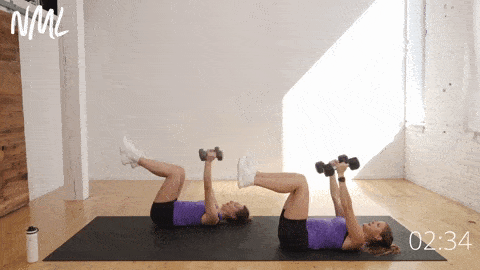
How To Do Weighted Dead Bugs
- Lie on your back flat on the floor, performing a slight pelvic tilt to press your lower back into the mat. Lift your knees to form a 90-degree angle (knees stacked on top of hips).
- Hold a dumbbell in each hand and extend your hands straight overhead toward the ceiling. Inhale, letting your belly expand.
- Exhale, engaging your core and simultaneously extending your left leg and right arm away from your body, lowering the dumbbell in your right arm towards the ground with control. Left arm and right leg remain in place. With control, inhale as you return to starting position.
- Then repeat on the opposite side, exhaling as you extend your right leg and left arm away from the body, lowering the dumbbell in your left arm towards the ground. With control, return to starting position.
9. Dumbbell V-Ups
Targets: External oblique, internal oblique, lower abs, rectus abdominis and shoulder muscles.
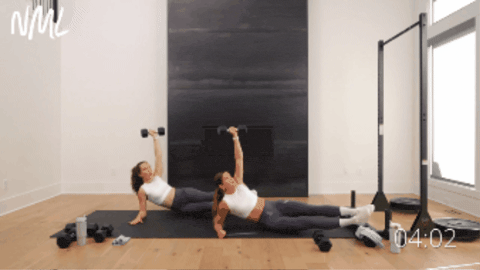
How To Do Oblique V-Ups
- Lie on your right side on the mat. Keep your body in a straight line, with your left leg stacked on top of the right, slight bend in the knees. Hold a dumbbell in your left hand overhead, left wrist stacked over left shoulder.
- Place your right forearm on the mat, right shoulder stacked over right elbow. Think about lifting up and out of your right side to avoid collapsing down to the mat.
- Engage your core, especially the obliques, and lift both legs up towards your left hand. Aim to keep your legs as straight as possible.
- Briefly hold, then lower the legs, hovering them off the mat.
FAQs
The dead bug is one of the best dumbbell ab exercises for beginners. This exercise helps you learn proper form by teaching you how to brace your core, which is the foundational skill behind all ab training, strength lifts and posture control. During the dead bug, your limbs are moving in a slow and controlled manner, which targets the deep core and reduces risk of injury.
10 minutes done 1-2x per week is enough to build ab strength if you train close to fatigue, control the tempo and progress load or reps weekly. If you’re looking for extra core engagement, check out my 30-Day Ab Challenge Workout Routine.
Dumbbell exercises help build the muscles needed for ab definition, but you won’t see your abs until your body fat is low enough to reveal them. A mix of core-focused strength training, nutrition, daily movement, weight training, cardio and fat loss are key for seeing visible abs.
Ab exercises can help relieve back pain by increasing spinal stability and reducing strain on your lower back during everyday movements. Weighted ab movements can also help correct imbalances that cause poor posture or anterior pelvic tilt, a common contributor to low back pain.
Stronger Core, Stronger You
You don’t need hours in the gym or tons of fancy equipment to build a strong core at home. This dumbbell ab workout brings you 9 effective, weighted moves that hit the upper abs, lower abs, obliques and deep core. Use it as a fast 10-minute finisher or a focused core day 1-2 times per week to build stability, reduce back pain and boost performance in everything else you do.
More Workouts
Ab WorkoutsPin This Dumbbell Ab Workout
